The scene has a certain bounding rectangle that encloses all graphics items you put into it while the view has a certain size on the screen.
Between the scene and the view there is a transformation matrix (2x3 for scaling, rotate, shear and translation). You can get it by QGraphicsView.transform().
Now if you put more ellipses into your plot increasing the scene size but want to still see all of them, you must zoom out and accordingly the widths of the ellipses will shrink too.
You don't want that. Okay, so why not resizing them (according to the current scaling factor) everytime the scale changes. Well, this is probably not very efficient.
The better solution is to not change the scale of the view, but just scale the positions manually while keeping the zoom fixed. That way no properties of the items except their position has to be changed.
Example (using PySide and Python 3 but easily adjustable to PyQt and Python 2):
from PySide import QtGui, QtCore
import random
class MyGraphicsView(QtGui.QGraphicsView):
def __init__(self, *args, **kwargs):
super().__init__(*args, **kwargs)
def wheelEvent(self, event):
if event.delta() > 0:
scaling = 1.1
else:
scaling = 1 / 1.1
# reposition all items in scene
for item in self.scene().items():
r = item.rect()
item.setRect(QtCore.QRectF(r.x() * scaling, r.y() * scaling, r.width(), r.height()))
app = QtGui.QApplication([])
scene = QtGui.QGraphicsScene()
scene.setSceneRect(-200, -200, 400, 400)
for i in range(100):
rect = QtCore.QRectF(random.uniform(-180, 180), random.uniform(-180, 180), 10, 10)
scene.addEllipse(rect)
view = MyGraphicsView(scene)
view.setHorizontalScrollBarPolicy(QtCore.Qt.ScrollBarAlwaysOff)
view.setVerticalScrollBarPolicy(QtCore.Qt.ScrollBarAlwaysOff)
view.resize(400, 400)
view.show()
app.exec_()
With the mousewheel you can scale the positions and then it looks like this:

As for the balance of size and number of ellipses - well it's all your choice. There is no generic rule. I recommend to not make the ellipses larger than the distance between the ellipses or they will overlap. In general I work with scene coordinates that are 1:1 with pixel sizes of the view (as I did in the example above, 400 pixels width of the view, 400 units width of the scene rectangle). Then I can easily imagine what a size of an ellipse of 10 will be, that is 10 pixels. If I want more I use more and if I want less I use less. But there is no rule for it, it's up to what you want.
 Conversely when there are only a few 10s the scene being smaller the ellipses are way to large.
Conversely when there are only a few 10s the scene being smaller the ellipses are way to large.